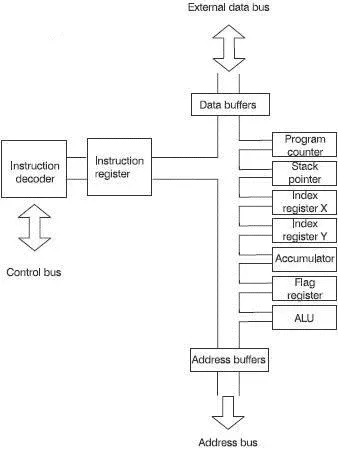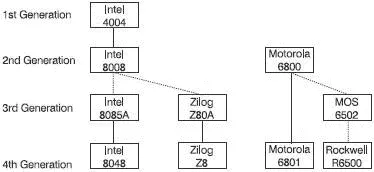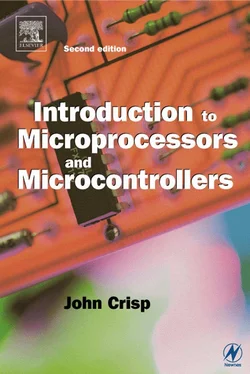John Crisp - Introduction to Microprocessors and Microcontrollers
Здесь есть возможность читать онлайн «John Crisp - Introduction to Microprocessors and Microcontrollers» весь текст электронной книги совершенно бесплатно (целиком полную версию без сокращений). В некоторых случаях можно слушать аудио, скачать через торрент в формате fb2 и присутствует краткое содержание. Год выпуска: 2004, ISBN: 2004, Издательство: Elsevier, Жанр: Компьютерное железо, на английском языке. Описание произведения, (предисловие) а так же отзывы посетителей доступны на портале библиотеки ЛибКат.
- Название:Introduction to Microprocessors and Microcontrollers
- Автор:
- Издательство:Elsevier
- Жанр:
- Год:2004
- ISBN:0-7506-5989-0
- Рейтинг книги:3 / 5. Голосов: 1
-
Избранное:Добавить в избранное
- Отзывы:
-
Ваша оценка:
- 60
- 1
- 2
- 3
- 4
- 5
Introduction to Microprocessors and Microcontrollers: краткое содержание, описание и аннотация
Предлагаем к чтению аннотацию, описание, краткое содержание или предисловие (зависит от того, что написал сам автор книги «Introduction to Microprocessors and Microcontrollers»). Если вы не нашли необходимую информацию о книге — напишите в комментариях, мы постараемся отыскать её.
Introduction to Microprocessors and Microcontrollers — читать онлайн бесплатно полную книгу (весь текст) целиком
Ниже представлен текст книги, разбитый по страницам. Система сохранения места последней прочитанной страницы, позволяет с удобством читать онлайн бесплатно книгу «Introduction to Microprocessors and Microcontrollers», без необходимости каждый раз заново искать на чём Вы остановились. Поставьте закладку, и сможете в любой момент перейти на страницу, на которой закончили чтение.
Интервал:
Закладка:
Returning to the plot
The 6502 was said to be ‘accumulator-based’ in that it has no general purpose registers and a single accumulator through which all the incoming and outgoing data is passed but with pipelining and some fast instructions – it was very popular for a few years. In comparing Figure 11.6 with Figure 11.5 we can see the influence of the MC6800. Most of the blocks are the same. The MC6800 had two accumulators and one index register and the MCS6502 has two index registers and one accumulator.

Figure 11.6 MCS6502 – an enhancement of the MC6800
There was little to choose between these microprocessors, as the 6502 had the edge in the microcomputer market while the MC6800 was more popular in the industrial control field.
The one-chip microcomputer
To make a stand alone system, the microprocessor would require some RAM and ROM memory as we saw in Figure 7.6. In many industrial control situations the size of the memory would not need to be very large and it occurred to the designers that all these necessary parts could be built into a single chip. When this occurred the name microprocessor was superseded by the one-chip microcomputer.
Intel produced the 8048. This was not simply an 8085+RAM+ROM, but a new design. It included (yet another) change of instruction code so it was not compatible with either the original 8080A or the 8085A. The on-board memory consisted of 1 kbyte of ROM and 64 bytes of RAM which was quickly doubled to 2 kbytes and 128 bytes on a new version, the 8049. It could also access 4 kbytes of external ROM. A further enhancement was a timer. This can count up or down to provide time delays. Without this, the microprocessor would have to be used for this function which would prevent it from getting on with something more useful.
Zilog, of course, were not far behind. It bought out the Z8. This was similar in concept but slightly upgraded. It had two counter/timers that could be used for counting incoming pulses as well as providing the time delays. It had 2 kbytes of ROM and 128 bytes of RAM that it called general purpose registers. A big improvement was its ability to access 64 kbytes of external ROM and 64 kbytes of external RAM to allow the ‘one-chip’ to become more than one if needed.
Motorola replied with its MC6801 that included many of the features of others in its generation. It included 2 kbytes of ROM and 128 bytes of RAM together with a timer and UART. Its instruction set was compatible with the MC6800 with a glimmer of 16-bit arithmetic creeping in.
Rockwell launched their R6500, which was basically a 6502 microprocessor with the addition of 2 kbytes of ROM and 64 bytes of RAM. One interesting feature was that the internal RAM had a separate power supply in the form of a battery so that the data wasn’t lost during a power failure. It also included a universal asynchronous receiver/transmitter (UART) that we will save for Chapter 15. The first four generations of microprocessors are shown in Figure 11.7.

Figure 11.7 The first four generations
As the home computer was being developed, the headlines were only interested in the ever-increasing speed and capability of the microprocessors. However, behind the scenes, the microcontroller was selling in greater numbers with little publicity. There is not much in the way of attention-grabbing headlines in a microcontroller being fitted into a video recorder.
The mammoth engines of today’s computers were just not required for many uses in the real world. We are the limiting factor when it comes to everyday uses of microelectronics. We may want our computers to work faster but we still work at the same speed that our ancestors. Just how fast do we want a vending machine to work? We want it to work at the same speed today as it did yesterday, or ten years ago. After all we cannot press the buttons any faster and we don’t want the coffee to fly down the chute at ten time the previous speed.
If we want any change, we may like it to be more reliable. Is the Pentium 4 any more reliable than the Z80? I doubt it. We would certainly want it to be cheaper and use less power, and not require a fan if it thinks about something.
The trend is to rethink what we really want and the answer in the majority of cases is something much closer to the present day microcontroller.
We will be coming back to microcontrollers in more detail in Chapters 15 and 16.
It was inevitable that the 4-bit microprocessor that turned into the 8-bit should, in turn, grow into a 16-bit microprocessor but first a few moments to answer a seemingly obvious question.
What do we mean by a 16-bit microprocessor?
The ‘size’ of a microprocessor is the width of the data registers, so an 8-bit microprocessor can handle 8-bit numbers. It was traditional that 4-and 8-bit microprocessors had an address bus that was twice the width of the data registers. This was just a coincidence and doesn’t follow these days since no one wants, or could afford, the memory to fully use a 128-bit address bus (the number of locations is more than 3 followed by 38 zeros!)
The other fallacy is that it is necessarily the same as the width of the data bus. It is not. The Pentium family uses a 64-bit data bus but they have 32-bit data registers and are therefore 32-bit devices. It uses the 64-bit data bus to load two 32-bit registers at a time. The Power PC and the Digital Alpha family are real 64-bit devices and have a 128-bit data bus.
Curiously, the Intel 8088 was a real 16-bit microprocessor but had an 8-bit external data bus. This was to allow it to be compatible with the cheaper 8-bit circuitry, which had not quite caught up with the idea of using 16 bits.
Even so, the data registers are not universally accepted as defining the size of a microprocessor. Some people stick with the data bus to be the defining size. So, in reference books and catalogues you may find microprocessors referred to as a different ‘size’ to the one you expected. In this book I will stick with the data register as being the defining feature.
The 68000 family
The M68000, first produced in 1979 was a VLSI chip employing about 70 000 transistors. The M68000 microprocessor is well known as a 16-bit microprocessor but, in reality, it is a 32-bit device if we stick to our definition above. It certainly has a 16-bit data bus but the internal registers are 32-bit although some arithmetic operations can only use 16-bit data. Occasionally this format is called a 16/32-bit processor. It was in a 64 pin dil (dual-in-line) package, as shown in Figure 11.4, but even longer. Its length was often its undoing since it could easily snap in half if you attempted to remove it by prizing up one end of the chip. It has a 24-bit address bus that can therefore access 16 Mbytes of memory with a 12 MHz clock frequency.
One feature of M68000 is its pre-fetch action. When an instruction is being worked on, the microprocessor fetches the next instruction from memory and stores it in a little queue, ready to be used. This can be done whenever the present instruction is not using the external address and data buses. This means that the next instruction is already loaded ready to go as soon as it is required, thus saving valuable time. It has a total of seventeen 32-bit general-purpose registers of which eight are data registers, which can be used as 8-, 16-, or 32-bit registers as required.
Читать дальшеИнтервал:
Закладка:
Похожие книги на «Introduction to Microprocessors and Microcontrollers»
Представляем Вашему вниманию похожие книги на «Introduction to Microprocessors and Microcontrollers» списком для выбора. Мы отобрали схожую по названию и смыслу литературу в надежде предоставить читателям больше вариантов отыскать новые, интересные, ещё непрочитанные произведения.
Обсуждение, отзывы о книге «Introduction to Microprocessors and Microcontrollers» и просто собственные мнения читателей. Оставьте ваши комментарии, напишите, что Вы думаете о произведении, его смысле или главных героях. Укажите что конкретно понравилось, а что нет, и почему Вы так считаете.












